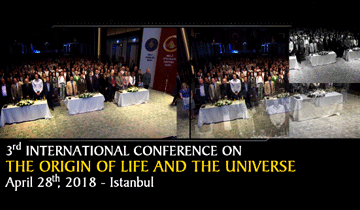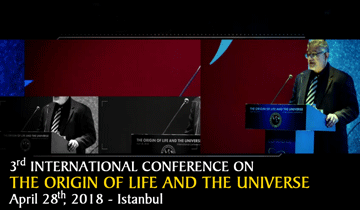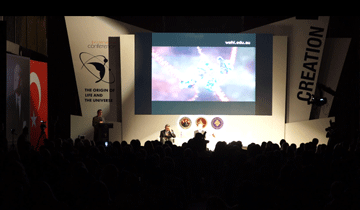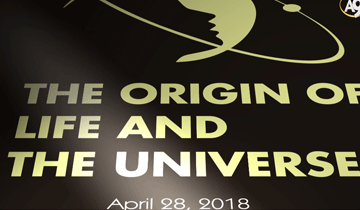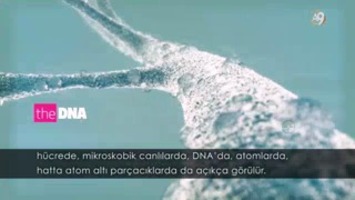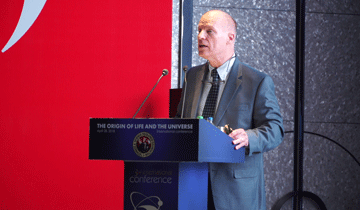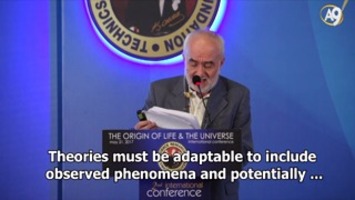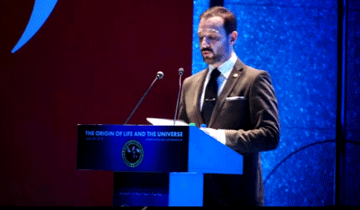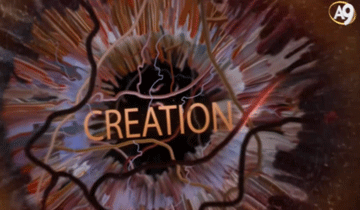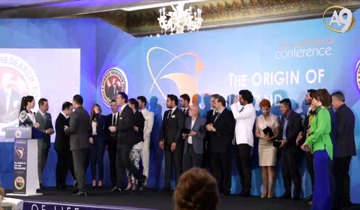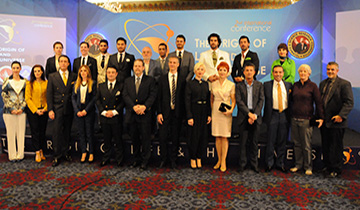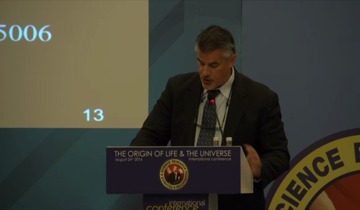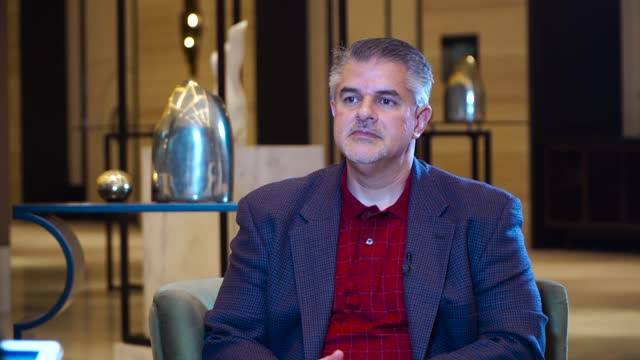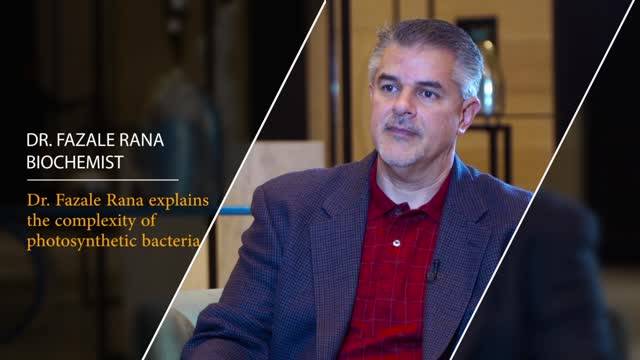Dr. Fazale (Fuz) Rana, Biochemist, USA, 3rd International Conference on the Origin of Life and the Universe, April 28th, 2018-istanbul
FAZALE RANA
The Human Genome
ENCODED by Design
Greetings!
I am honored to be invited to take part in this year’s 3rd International Conference on the Origin of Life. I had the privilege of speaking at the first two conferences. And, I am grateful for the opportunity to participate in this year’s conference. Thank you to the Technics and Science Research Foundation for the vision to sponsor and host such an important event.
It’s exciting to be part of a project in which one of the goals is to show the world how science can be used to build a bridge of friendship between Christians and Muslims. Based on our shared belief in a transcendent Creator, we can collaborate to demonstrate to people of all worldviews how scientific advance 1) points to the existence of God; and 2) undermines the evolutionary paradigm—a paradigm often used to justify atheism.
As a Christian and a scientist, I am convinced that nature provides evidence for God’s handiwork. As is written in the Old Testament book of Job:
7“But ask the animals, and they will teach you,
or the birds in the sky, and they will tell you;
8 or speak to the earth, and it will teach you,
or let the fish in the sea inform you.
9 Which of all these does not know
that the hand of the Lord has done this?”
13 “To God belong wisdom and power;
counsel and understanding are his.
Job 12:7-9, 13
And yet, when presented with compelling evidence for design that comes from biology, so many skeptics reject the evidence—and with this rejection, they reject belief in God.
Why?
They justify their skepticism by pointing to so-called flawed designs in nature—designs that would be unworthy of a Creator.
As the late, evolutionary biologist and atheist Stephen Jay Gould wrote in his famous essay, “The Panda’s Thumb”
“Odd arrangements and funny solutions are the proof of evolution—paths that a sensible Creator would never tread but that a natural process, constrained by history, follows perforce.”
And, yet in my experience, as we learn more about the so-called “odd arrangements and funny solutions” inevitably, what we thought was a flawed design turns out to be an elegant, sophisticated design—one that reflects the Creator’s glory.
The latest scientific insights into the human genome beautifully illustrate this point.
As a biochemist and someone who has spent most of my life studying biology, I rank the sequencing of the human genome as the most significant scientific accomplishment of all time all-time.
Why?
Because the human genome sequence is the genetic blueprint for human beings. From our genetic blueprint, we can gain fundamentally important information about the nature of humanity—at least, in a biological sense.
The draft sequence of the human genome was reported in June 2000. There is a famous picture showing then President Bill Clinton standing next to two gentlemen and bitter scientific rivals: Francis Collins, the head of the Human Genome Project funded in part by NIH; and Craig Venter, the head of Celera Genomics, a private company that was looking to sequence and commercialize the human genome.
The Human Genome Project funded by NIH was initiated fifteen years earlier, spending 3.2 billion dollars to sequence the human genome. Celera was in a race with the Human Genome Project, hoping to complete the sequence before the publically funded project. If they could, they planned on monetizing the sequence data.
As it turns out, Collins and Venter decided to call a truce, agreeing to walk arm-in-arm across the finish line. In the process, they shared data with one another facilitating the completion of the draft sequence.
During the press conference President Clinton made these now-famous remarks:
“Today, we are learning the language in which God created life. We are gaining ever more awe for the complexity, the beauty, the wonder of God's most divine and sacred gift. With this profound new knowledge, humankind is on the verge of gaining immense, new power to heal. Genome science will have a real impact on all our lives—and even more, on the lives of our children. It will revolutionize the diagnosis, prevention and treatment of most, if not all, human diseases.”
Truly, President Clinton appreciated the significance of having the sequence for the human genome. He went so far as to describe the human genome sequence as the language God used to create human life.
Yet, the initial analysis of the human genome sequence indicated to many scientists that the human genome was anything BUT the product of Creator’s handiwork. Instead of being the language God used to create human life, it appeared to many scientists that the human genome was cobbled together over hundreds of millions of years by evolutionary processes, with much of the human genome riddled with molecular fossils—vestiges of an evolutionary history.
Many scientists would argue that the human genome stands as the most powerful evidence for human evolution, while, at the same time, indicating that God had nothing to do, whatsoever, with humanity’s origin.
In the next few minutes, I will explain why scientists reached these conclusions.
Then I’m going to describe some recent insights into the structure and function of the human genome that is radically changing our perspective on the human genetic blueprint in a way that reflects the Creator’s handiwork.
Let’s begin with a little background information, beginning with the structure of DNA.
This biomolecule consists of chain-like molecules known as polynucleotides. Two polynucleotide chains align in an antiparallel fashion to form a DNA molecule. The two strands are arranged parallel to one another with the starting point of one strand (the 5' end) in the polynucleotide duplex located next to the ending point of the other strand (the 3' end) and vice versa. The paired polynucleotide chains resemble a ladder with the side groups extending from the backbone interacting with each other to form rungs. The coupled polynucleotide chains twist around each other forming the well-known DNA double helix.
The cell's machinery forms polynucleotide chains by linking together four different subunit molecules called nucleotides. The four nucleotides used to build DNA chains are adenosine, guanosine, cytidine, and thymidine—famously abbreviated A, G, C, and T, respectively.
The human genome consists of 3.2 billion genetic letters that are distributed among 24 discrete DNA molecules. These molecules interact with proteins to form complexes called chromosomes. These structures become visible in the cell nucleus as the cell divides. Each chromosome consists of a single DNA molecule that wraps around a series of globular protein complexes. These wrapped complexes repeat to form a supramolecular structure resembling a string of beads. Biochemists refer to the “beads” as nucleosomes.
The chain of nucleosomes further coil to form a structure called a solenoid. The solenoid condenses to form higher order structures that constitute the chromosome. Between cell division events, the chromosome exists in an extended diffuse form that is not detectable. Prior to and during cell division, the chromosome condenses to form its readily recognizable compact structures.
All the genetic material (DNA) in the cell’s nucleus is distributed among numerous chromosomes. The number of chromosomes in its cells is a characteristic feature of each species. For example, in the nucleus of each cell, chimpanzees possess 48 chromosomes and humans, 46.
The human genome is comprised of 22 autosomes, numbered 1 to 22 based on size, with chromosome 1 being the longest and chromosome 22 being the shortest. There are also two sex chromosomes, dubbed the X and Y chromosomes.
Every cell in the human body has 23 pairs of chromosomes, one set comes from the mother, one from the father. The set is made up of 22 autosomes and 1 sex chromosome, either X or Y.
One of the surprises about the human genome came shortly after the rough draft sequence was produced. The initial analysis indicated only 20,000 genes exist in the human genome. This was a far cry from the predicted number: 100,000 genes, at minimum.
This meant that less than 2 percent of the human genome coded for proteins—the workhorse molecules of the cell. Evolutionary biologists interpreted the rest of the human genome as junk DNA.
Evolutionary biologists argue that most of the human genome looks like it was derived from retroviral infections. Also, included in the human genome are nonfunctional genes, dubbed pseudogenes, along with other types of evolutionary debris. At first glance, the human genome looks like a vast wasteland of junk.
Of course, this begs the question: Why would a Creator make the human genome with so much useless DNA?
In Psalm 8 of the Old Testament, David asks the question:
What is mankind that you are mindful of them,
human beings that you care for them?
David answers his own question by remembering the Genesis 1 and 2 creation accounts for humanity’s origin. David replies:
You have made them a little lower than the angels
and crowned them with glory and honor.
You made them rulers over the works of your hands;
you put everything under their feet:
Given David’s words, a human genome littered with garbage is not what one would expect if human beings are the crown of creation. But, it is exactly what one would predict, if evolution cobbled together the human genome.
For evolutionary biologists, a high level of junk DNA in the human genome (and the genomes of other creatures) provides resolution to the C-Value paradox, adding to the case for evolution.
The C-Value paradox traces its origins back to the late 1960’s, early 1970’s. At that time, biochemists developed techniques to quantify the amount of DNA found in individual cells. They used these techniques to measure the amount of DNA in the different cell types comprising an organism. For example, human beings have approximately 210 different cell types that make up our bodies. Biochemists were interested in the amount of DNA in each of these cell types. For every organism studied, biochemists found that all the cells in their body contained the same amount of DNA. They dubbed this value as the C-value, with C standing for ‘constant.’ The C-value refers to the constant amount of DNA found in each of an organism’s cells.
At that time, biochemists thought that the amount of DNA should correspond to the complexity of the organism. More complex organisms should have more DNA, than less complex organisms. When biochemists plotted C-values for different organisms, they failed to discover any relationship between complexity and quantity of DNA in the organism’s cells.
The discovery of junk DNA resolved the C-value paradox. Accordingly, most of an organism’s genome consisted of junk DNA, which accumulated through random events. As a result, the C-value varied from organism to organism, with no rhyme or reason. In other words, the size of an organism’s genome has no relationship to complexity. It is just the vestiges of an unguided, evolutionary history.
This of course begs the question: Why would an all-powerful, all-knowing God create genomes with more junk than functional DNA?
An even more problematic question: Why would organisms that naturally group together possess identical (or nearly identical) junk DNA sequences at corresponding locations in their genomes?
On the surface, the explanation that makes most sense is an evolutionary one; the junk DNA sequences arose in the shared evolutionary ancestor and persisted in the genomes as the different evolutionary lineages diverged from the common ancestor. In other words, junk DNA sequences in our genome and the genomes of other organisms reflects our evolutionary history and can be used to map evolutionary relationships.
Yet, over the course of the past decade, molecular biologists and geneticists have made discoveries that force us to re-think the evolutionary view of the human genome. Bit by bit researchers have discovered that most of the classes of junk DNA have function.
Of course, if junk DNA is functional, it undermines the case for evolution. One could argue that the shared junk DNA sequences in corresponding locations in genomes reflects common design, not common descent.
The case for the design of the human genome became stronger virtually overnight, thanks to the ENCODE project. This project was initiated shortly after the human genome was sequenced. It became immediately apparent that simply having the DNA sequence for the human genome was not enough. There had to be some means to interpret the sequence data. Nobody knew how to read the 3.2 billion genetic letters, comprising our genome. We knew how to fish out gene sequences from the human genome. But, nobody knew what the rest of the genome sequences meant, if anything, at all.
Scientists needed a Rosetta stone for the human genome.
Hence, the ENCODE project was birthed. Its goal: To identify all the functional elements in the human genome. ENCODE stands for the Encyclopedia of DNA Elements.
This project began in the early 2000’s. The pilot phase cost 55 million dollars—an expense pilot study. The research consortium attempted to identify all the functional elements in 1 percent of the human genome. Their success with phase I, lead to phase II. This phase cost 130 million dollars and was completed in September of 2012. Phase III is currently under way. The total cost of the ENCODE project will be about 300 million dollars—a bargain, because to sequence the human genome cost 3.2 billion dollars. We will be able to interpret the human genome for a mere tenth of the cost of sequencing our genetic blueprint.
The ENCODE project was ‘Big science’ coming to biology. The ENCODE consortium for phase II consisted of:
440 Scientists
32 Research Groups
Performed 1650 Experiments
Analyzed 147 cell types
Produced 15 X 1012 bytes of data
Required 300 years of computer time to analyze
The ENCODE consortium produced:
Nearly 40 publications
Nature
Science
Cell
Genome Research
Genome Biology
Journal of Biological Chemistry
Phase III of the ENCODE project will survey the remaining 63 cell types for functional DNA and look for functional DNA at different stages of the cell cycle.
This data will go a long way towards helping us gain a fundamental understanding about human biology and human uniqueness.
We will be able to develop a better understanding of the genetic basis of diseases and develop diagnostic tools and improved treatments for many of these disorders.
The insights coming from ENCODE also impacts the creation/evolution controversy.
These results:
Eliminates best argument for evolution
Eliminates biggest challenge to biochemical design
What did ENCODE find that is so important to the case for a Creator?
These researchers performed six assays that measured
Transcription
Binding of transcription factors
Histone binding
Modified histone binding
Methylation
3-D interactions within the genome
All these processes play a key role in gene expression.
It is one thing to know what genes are present in the genome. It is another to know how and when those genes are used. We can think of genes within the genome like words in a dictionary. To write a novel, one needs to use the words in the dictionary in a variety of combinations, often using words more than one time. Each novel uses words from the dictionary in different ways to produce pieces of literature that communicate different meanings.
The set of genes found in the genome are like the words in the dictionary. These genes can be used to build each cell in the human body, with the cells functioning like novels. The genes are used or expressed differently from cell to cell, accounting for their unique features.
Gene expression not only differs from cell to cell, it also changes throughout the cell cycle and during growth and development. Each stage of the cell cycle, each stage of development represents a different novel that needs to be written.
It appears as if most of the DNA sequences found in the human genome are regulating gene expression needed to build, and then, maintain the human organism. Phase II of the ENCODE project reported that 80 percent of the human genome displays biochemical activity that likely reflects biochemical function.
The ENCODE scientists expect that as phase III comes to fruition, 80 percent will become 100 percent.
Ed Yong wrote in an article for Discover magazine:
And what’s in the remaining 20 percent? Possibly not junk either, according to Ewan Birney… “It’s likely that 80 percent will go to 100 percent,” says Birney.
Ewan Birney serves as the head of the ENCODE consortium.
The human genome doesn’t appear to be a wasteland of junk. It appears to be functional. Most of the DNA sequences in the human genome play a role in making us human beings. This insight stands as a radical revision of our view of the human genome. It is not a wasteland of junk, but an elegant biochemical system that is far more complex than we initially imagined.
How have biologists responded to the ENCODE results?
Within hours of the publication of the phase II results evolutionary biologists condemned the ENCODE project, citing several technical issues with the way the study was designed and the way the results were interpreted.
These technical complaints continue today, igniting the junk DNA wars between evolutionary biologists and genomics scientists. Evolutionary biologists argue that if the results of the ENCODE project are correct, then cornerstone ideas in evolutionary theory—such as the C-Value paradox— can’t be correct. On the other hand, genomics scientists see value in the ENCODE results, using them to understand the genetic basis for disease.
Evolutionary biologists have roundly criticized ENCODE scientists, claiming them to be incompetent and decrying the design of the ENCODE assays. Evolutionary biologists claim that if ENCODE is correct, then key aspects of the evolutionary paradigm are in trouble.
These critics are doing science, ‘backwards.’ Instead of data used to evaluate a theory, the theory is used to evaluate the data.
The character of these objections aren’t lost on objective members of the scientific community who have suggested the real motivation behind the criticisms of the ENCODE project are philosophical—even theological—in nature.
For example, molecular biologists John Mattick and Marcel Dinger write in an article published in the scientific journal HUGO Journal:
“There may also be another factor motivating the Graur et al. and related articles (van Bakel et al. 2010; Scanlan 2012), which is suggested by the sources and selection of quotations used at the beginning of the article, as well as in the use of the phrase ‘evolution-free gospel’ in its title (Graur et al. 2013): the argument of a largely non-functional genome is invoked by some evolutionary theorists in the debate against the proposition of intelligent design of life on earth, particularly with respect to the origin of humanity. In essence, the argument posits that the presence of non-protein-coding or so-called ‘junk DNA’ that comprises >90% of the human genome is evidence for the accumulation of evolutionary debris by blind Darwinian evolution, and argues against intelligent design, as an intelligent designer would presumably not fill the human genetic instruction set with meaningless information (Dawkins 1986; Collins 2006). This argument is threatened in the face of growing functional indices of noncoding regions of the genome, with the latter reciprocally used in support of the notion of intelligent design and to challenge the conception that natural selection accounts for the existence of complex organisms (Behe 2003; Wells 2011).”
John Mattick who wrote these words is not friendly to creation or intelligent design.
Our understanding of genomes is in its infancy. Forced by their commitment to the evolutionary paradigm, many biologists see genomes as the cobbled-together product of an unguided evolutionary history. But, the more we learn about the structure and function of genomes, the more elegant and sophisticated they appear to be—and the more reasons to think that genomes are the handiwork of our Creator.
I would like to conclude with the words of Eric Green, the Director of the National Human Genome Research Institute:
“During the early debates about the Human Genome Project, researchers had predicted that only a few percent of the human genome sequence encoded proteins, the workhorses of the cell, and the rest was junk. We now know that this conclusion was wrong. ENCODE has revealed that most of the human genome is involved in the complex molecular choreography required for converting genetic information into living cells and tissues.”
In light of the data coming from the ENCODE project, as a Christian I am justified in viewing the human genome, and hence, human beings as the product of a Creator’s handiwork.
In Psalm 139, David sings a song of praise to the Creator, summarizing the latest insights from the ENCODE project well, when he declares:
I praise you because I am fearfully and wonderfully made; your works are wonderful, I know that full well.


